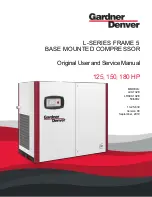
12
o
Attach the air line only and block the end. Verify the pressure gauge
needle indicates an increase in pressure. Remove the blockage from the
end of the air line and observe whether or not a small burst of
compressed air is released. If pressure cannot be built at the end of the
air line, check the air line for cuts, kinks and holes, especially at, and
near, the bladder pump hose barb or compression fitting connections.
•
If
pressure
can
be built at the end of the air line while the compressor is running:
o
Attach the airline to the bladder pump. Remove the fluid discharge tube
from the bladder pump. While the compressor is running, very little air
discharge should be felt at the pump discharge fitting. The pressure
gauge on the front of the control pro should indicate a rise in pressure. If
this does not occur and a continuous air flow can still be felt at the pump
fluid discharge fitting, then the bladder, or bladder seal, has been
compromised and should be repaired or replaced. Information on this
procedure can be found in the product manual specific to the bladder
pump being used. Or call 1-800-833-7958 for further assistance.
o
Reminder
: Be careful not to over pressurize and crease the bladder
inside the pump as this will reduce the fluid flow during normal operation.






































